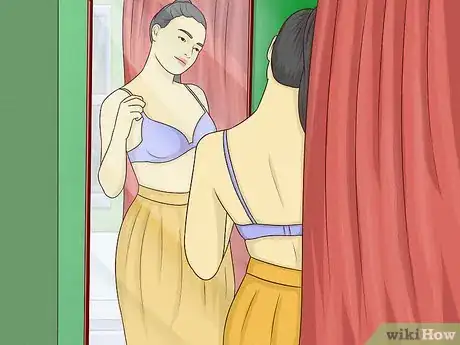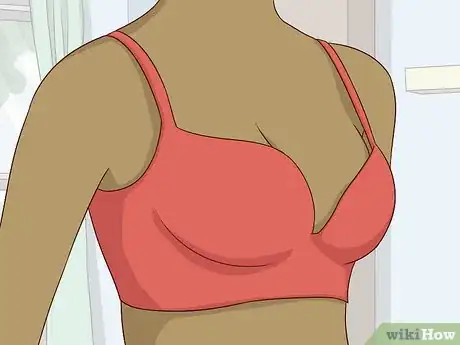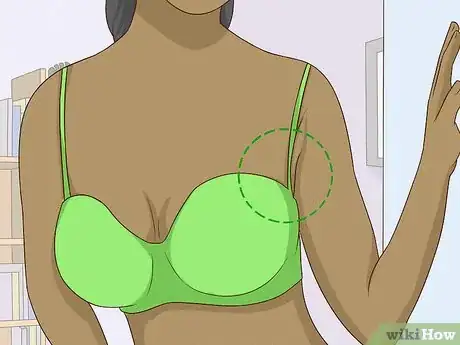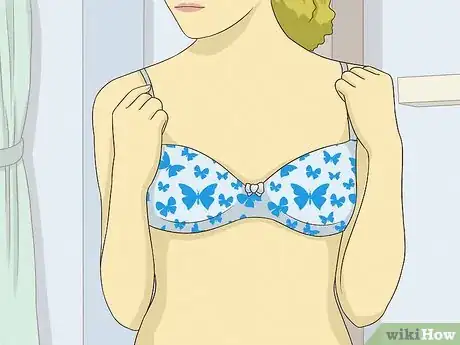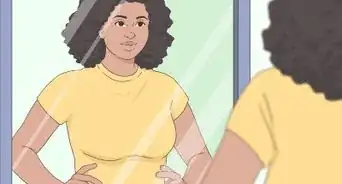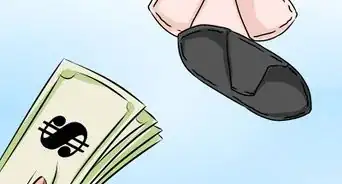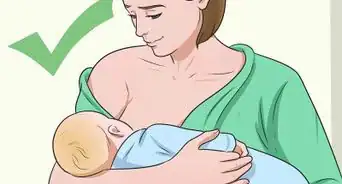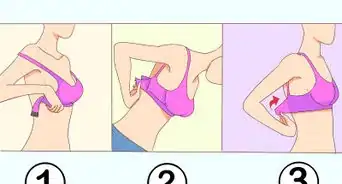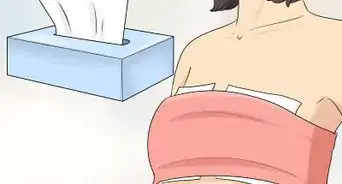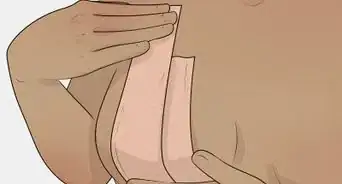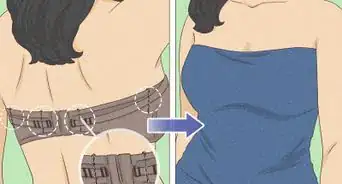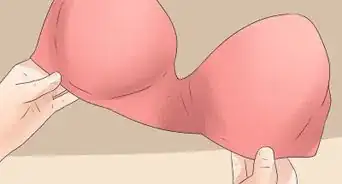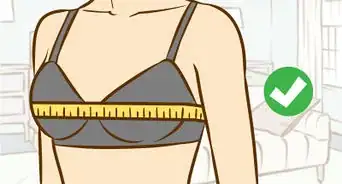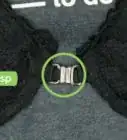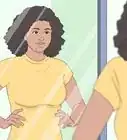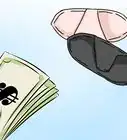This article was co-authored by Hannah Park. Hannah Park is a professional stylist and personal shopper with experience in e-comm styling, celebrity styling and personal styling. She runs an LA-based styling company, The Styling Agent, where she focuses on understanding each individual she works with, and crafting wardrobes according to their needs.
wikiHow marks an article as reader-approved once it receives enough positive feedback. In this case, several readers have written to tell us that this article was helpful to them, earning it our reader-approved status.
This article has been viewed 839,788 times.
A bra is something that you may take for granted, but finding the right bra can do wonders for both your appearance and self-esteem. It may take time to find the right bra for you, but remember: you’re worth it. Here’s a guide to finding the right bra for you.
Steps
Measuring Your Bra Size
-
1Find your band size. Use a soft measuring tape to measure around your ribcage just below your bust, where your bra band would normally be located. Keep the tape snug around your chest. Round the measurement up to the nearest 1 inch (2.5 cm), then add 4 inches (10 cm) if it’s an even number and 5 inches (13 cm) if it’s odd.[1]
- For example, if you measured 31 inches (79 cm), your band size would be 36.
- This measurement is taken tightly because you want the band of your bra to be very snug.
-
2Measure bust at the fullest part to get your bust size. Wrap the tape around your bust at its fullest point, so that the tape passes over the nipples. Don’t pull the measuring tape too tight.[2]
- If you do not measure exactly to the inch, round up.
-
3Subtract the band size from the bust size to find your cup size. The cup sizes are based on the difference between your band and bust size rather than on the size of your breasts alone. For every 1 inch (2.5 cm) difference, go up a cup size. For example:[3]
- A difference of 0 inches (0 cm) is an AA cup.
- A difference of 1 inch (2.5 cm) is an A cup.
- A difference of 2 inches (5.1 cm) is a B cup.
- A difference of 3 inches (7.6 cm) is a C cup.
- A difference of 4 inches (10 cm) is a D cup.
- If your cup size is greater than a D, different manufacturers will classify your cup size differently, so you may have to try different cup sizes when you fit bras.[4]
-
4Know that the size of the cup varies with the band size. It's important to realize that the size of the cup will increase along with the band size, and vice versa. For example, the cup of a size 36C bra will be bigger than the cup of a size 34C bra. So:
- If you want to try a smaller band size, you’ll need to compensate by choosing a larger cup size. For example, if you find the band on a 36B bra is too loose, go for a 34C instead.
- And if you want to try a larger band size, you’d need a smaller cup. For example, if a 34B is too tight around the band, try a 36A.
Using the Proper Fitting Technique
-
1Hook the bra at your waist, then pull up only in the front. Lift the front up as high as it will go, without sliding over the front of your breasts.
- This will make sure the back stays low, for proper support.
- This will also ensure you get lift in front, where you want it.
-
2Lean forward and smooth all the soft tissue forward. Start from just behind your armpits, and push as much as you can into the cup.
- Breast tissue is soft, and if your bra fits properly, it should stay where you put it.
- Grasp the front of the bra and jiggle slightly to settle everything into place.
-
3Know how high on your chest your breasts should end up. With a properly fitted bra, the apex of your breasts should be approximately halfway between your elbow and your shoulder.
-
4Don’t overtighten the closures or straps. Doing so can make the bra uncomfortable, and this can affect your mood and posture.
- Never tighten the straps so much that they put pressure on your shoulders. This will cause you to slouch forward.
- Never tighten the straps so they pull the bra up at the back. Keeping the back band straight across is important for adequate support in front.
- When buying a bra, hook into the loops at the very end of the band. This gives you a way to tighten the bra as it stretches out over time.
-
5Get a professional fitting regularly. Your breast size will change along with other changes in your body.
- Get fitted every time you lose or gain more than 10 pounds (4.5 kg) or have hormonal changes such as with pregnancy or hormone therapy. [5]
- Many lingerie stores and departments offer free professional fitting.
- Don’t be embarrassed! These women are usually very kind and professional, and have seen it all before.[6]
- Try to get fitted at a store with a wide range of brands and sizes, otherwise the information you get might be limited to what the store actually sells.
Shopping for Your Bra
-
1Find a good retailer. While bras are widely available, most stores cater to “average” sizes. Find a store or a brand that is particularly suited to your body type.
- If you have a hard time shopping in department stores, consider going to specialty lingerie stores or ordering online.
- Don’t feel pressured to buy in any store or from a particular salesperson. There are many options to choose from!
-
2Plan your budget beforehand. Bras can be expensive, but it’s important not to sacrifice good fit for the sake of paying less.
- An ill-fitting bra is not worth buying. It will eventually make you uncomfortable, both physically and psychologically.
- Plan to have fewer bras in your wardrobe, if necessary. Buy bras that are versatile, such as “convertible” styles, or ones with removable straps. Thinks about the color of the clothes in your wardrobe and aim to buy bras to match.
-
3Always fit your bra before you buy it. Your size is just a starting point, as sizing can vary and every bra will fit a little bit differently. Take the time to try it on in the store and make sure it’s right.
- When shopping for bras, plan to spend a fair amount of time in the store choosing and fitting bras. Don’t be frustrated if you don’t find the right fit right away.
- If you order online, make sure the site you buy from has a good return policy.
-
4Know which styles are flattering. The shape of your breasts and torso are unique. Depending on your particular proportions, certain styles will look better on you than others.
- Your bra will look better if it flatters the overall proportion of your torso. Ideally, your shoulders should look about the same width as your hips.
- If your shoulders are broad, try to find bras with narrower set straps, and a shape that plunges more in the middle.
- If your shoulders are narrow, consider bras that create a more distinct horizontal line across your torso.
- If your torso is short, a bra that plunges more in the middle can elongate your torso.
- Consider the shape of your breasts. There is a wide variety of breast shapes and sizes. To understand how to classify your breasts, look at this guide.
- Choose strapless bras to wear under tank tops.[7]
- Alternatively, you can buy a bralette.[8]
- Buy bralettes that match your dress.[9]
- Keep in mind that it is better not to fold bras. They should be laid flat in the dresser.[10]
- Bralettes can be folded and laid down flat.[11]
-
5Try moving around to make sure the bra stays put. Put your arms above your head and twist left and right at the waist.
- The bra should neither ride up nor pinch at this point. If the band slips, try a smaller size. If it cuts in, it's too tight.
- If you're trying on a sports bra, jog in place or jump up and down as well to test if it can control 'bounce' comfortably.
- Bend over. If your breasts are falling out, then the bra doesn't fit.
-
6Modify your bra if needed. There are plenty of add-ons that can make your bras more comfortable.
- Everyone has one breast larger than the other. Adjust each strap to the correct length and consider padding one side.
- If your bra band is too tight, consider purchasing a band extender.
- If your straps hurt because they're cutting into your shoulders, you may benefit from strap padding.
- If the straps keep falling off your shoulders, consider a clip to hold them together in the back.
-
7Make peace with your breasts. If you’re unhappy with your body, bra shopping can be a truly unpleasant experience. However, it's important to remember that every woman's body is unique, but bras are mass produced. No bra can ever be made to look good on everyone.
- Remember that even with a perfect body (if such a thing exists) an ill-fitting, unflattering bra can do a woman a great disservice.
- If something doesn't suit you, remember that you can always wear something else. Refrain from passing judgement on yourself.
- If you’re having a hard time finding a bra, this doesn't mean you are ugly or strangely shaped. It just means you’re different.
Identifying Common Fitting Problems
-
1Know the parts of a bra.[12] In order to pinpoint where a bra does or does not fit well, be aware of the various part of a bra.
- The cup: The part where your breasts fit into. It’s usually made of stretchy fabric, and can have up to 3 tailored seams.
- The band: This is the elastic part that goes all the way around your chest.
- The wings: These are the portions of the band that extend from the end of the cups to the center of the back.
- The straps: These go over the shoulders and are often adjustable, and sometimes padded.
- The closure: This is usually a hook and eye set at the center back. However, it can also be in front, or absent.
- The center gore: This is the part between the cups in the front.
-
2Count your breasts. If you appear to have 4, you have what is called the “quad boob effect.” This indicates that the cups are too small, and there's not enough room inside.
- This is especially apparent if you try your shirt on over your bra.
-
3Check to see that the bra doesn't slide over your breasts. If it does, this means that the band is too loose.
- Try raising your arms and bending backward a bit to check if this happens.
- Remember, when you go up a band size, go down a cup size.
-
4Check that the middle of the bra is lying flat in front. If it won’t, then the bra doesn't fit.
- This could be because the underwire is the wrong shape for your breasts.
- It could also indicate that the cup size is either too large or too small.
-
5Check that the band doesn't ride up your back or dig into your sides. You should be able to run your fingers around under the edge of the fabric.
- If you can pull it away from your back by more than 1–2 inches (2.5–5.1 cm), it's too loose.
- If the band digs into your sides to the extent that it causes pain after wearing it, the band is too small.
- If the band rides up, try loosening the straps. If this doesn’t work, the band is too big.
-
6Note that “back fat,” a common complaint, is normal. This does not necessarily mean the band is too tight.
- Instead, look for bras that have a wider band or a “leotard band” to create a smoother silhouette.
- Unless the band is causing you pain, don’t go up a band size, otherwise you will not have enough support.
- This could also indicate that the cup size is too small.[13]
- Another solution is to wear a body shaping undergarment.
-
7Make sure the cups don’t wrinkle or have gaps at the top. This could mean that the cup size is too big, the style is wrong, or that you have not put the bra on properly.
- Try adjusting your breasts to make sure they are centered in the cup.
- This could also mean that the bra is not right for your breast shape.
- If your breasts are fuller at the bottom than at the top, you may need a differently shaped bra, such as a “demi cup” or “balcony” style bra.
-
8Check that the straps do not dig into your shoulders. This can cause pain, and other problems.
- Straps that dig into your shoulders can cause long term problems, such as headaches, back pain, permanent indentations, and even nerve damage.
- Try looking for bras with wide, padded straps, especially if you have larger breasts.
- Shoulder pain could also indicate that the band is too big and not providing enough support. The support should come from the band, not the straps.
-
9Check that the straps do not fall off your shoulders. If you’ve adjusted the straps and they still keep falling, try a different bra.
- Petite women and women with sloping shoulders often have this problem.
- Make sure the straps are set close enough together and are fully adjustable.
-
10Make sure any underwires are comfortable. Underwires that are fitted properly should not cause any pain or discomfort.
- If the cup is too small, the underwire may not fit comfortably under your breasts.
- Also, your individual breasts may not necessarily be the same shape as the manufacturer’s underwires.
- You may have trouble wearing underwires if you have a higher rib cage.
- Underwires are not recommended for pregnant women or women undergoing surgery.
- Some medical conditions may also make it inadvisable to wear underwires.
- Bras without underwire can be just as supportive, even if you have larger breasts, as long as the fit is correct.
Expert Q&A
-
QuestionHow can I keep my bralettes and bras?
 Hannah ParkHannah Park is a professional stylist and personal shopper with experience in e-comm styling, celebrity styling and personal styling. She runs an LA-based styling company, The Styling Agent, where she focuses on understanding each individual she works with, and crafting wardrobes according to their needs.
Hannah ParkHannah Park is a professional stylist and personal shopper with experience in e-comm styling, celebrity styling and personal styling. She runs an LA-based styling company, The Styling Agent, where she focuses on understanding each individual she works with, and crafting wardrobes according to their needs.
Professional Stylist You can fold the bralettes in half, lay them down flat, and color coordinate them. It is not good to fold bras. Lay them out flat in your dresser.
You can fold the bralettes in half, lay them down flat, and color coordinate them. It is not good to fold bras. Lay them out flat in your dresser. -
QuestionWith what can I wear bralettes?
 Hannah ParkHannah Park is a professional stylist and personal shopper with experience in e-comm styling, celebrity styling and personal styling. She runs an LA-based styling company, The Styling Agent, where she focuses on understanding each individual she works with, and crafting wardrobes according to their needs.
Hannah ParkHannah Park is a professional stylist and personal shopper with experience in e-comm styling, celebrity styling and personal styling. She runs an LA-based styling company, The Styling Agent, where she focuses on understanding each individual she works with, and crafting wardrobes according to their needs.
Professional Stylist You can wear bralettes with a low-cut dress, a shirt with many holes, or a see-through mesh. Remember to match their colors with the dress.
You can wear bralettes with a low-cut dress, a shirt with many holes, or a see-through mesh. Remember to match their colors with the dress. -
QuestionMy breasts fall out the bottom of my bra, and I can't seem to find a bra that fits me! What can I do?
 Community AnswerGo to a store that specializes in lingerie, and have a staff member measure you. This may be a bit awkward, but believe me, you'll be walking on air when you find the right one.
Community AnswerGo to a store that specializes in lingerie, and have a staff member measure you. This may be a bit awkward, but believe me, you'll be walking on air when you find the right one.
Warnings
- Be aware that bras may contain materials that you are allergic to, which you may not be aware of when you make your purchase. If you experience any swelling (such as hives) or excessive itching, then you may be allergic to nickel or the plastics in the bra. Take note of where the allergic reaction happened and watch out for that material the next time you decide to buy a bra. In the meantime, take some Benadryl, or in extreme cases, get to the emergency room.⧼thumbs_response⧽
References
- ↑ https://www.realsimple.com/beauty-fashion/clothing/shopping-guide/how-to-measure-bra-size?slide=126291#126291
- ↑ https://www.realsimple.com/beauty-fashion/clothing/shopping-guide/how-to-measure-bra-size?slide=126291#126291
- ↑ https://www.realsimple.com/beauty-fashion/clothing/shopping-guide/how-to-measure-bra-size?slide=56307#56307
- ↑ http://www.wizardofbras.com/fittingschool.aspx
- ↑ http://www.goodhousekeeping.com/beauty/fashion/best-bra-guide-0800-2
- ↑ http://www.wizardofbras.com/fittingschool.aspx
- ↑ Hannah Park. Professional Stylist. Expert Interview. 21 February 2019.
- ↑ Hannah Park. Professional Stylist. Expert Interview. 21 February 2019.
- ↑ Hannah Park. Professional Stylist. Expert Interview. 21 February 2019.
- ↑ Hannah Park. Professional Stylist. Expert Interview. 21 February 2019.
- ↑ Hannah Park. Professional Stylist. Expert Interview. 21 February 2019.
- ↑ http://www.wizardofbras.com/fittingschool.aspx
- ↑ http://www.wizardofbras.com/fittingschool.aspx
About This Article
To buy a well-fitting bra, start by measuring yourself to make sure you pick the right size. First, wrap the measuring tape around your rib cage just below your bust to figure out your band size. Round the measurement up to the nearest 1 inch, then add 4 inches if it’s an even number and 5 inches if it’s odd. Next, wrap the tape around your bust at its fullest point, right over the nipples. If you do not measure exactly to the inch, round up. Then, subtract the band size from the bust size to find your cup size. For every 1 inch of difference, go up a cup size. For example, a difference of 0 inches is an AA cup, a difference of 1 inch is an A cup, and a difference of 2 inches is a B cup. For more information on buying a well-fitting bra, like how to identify common fitting problems, read on!











